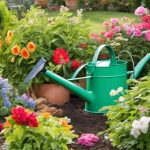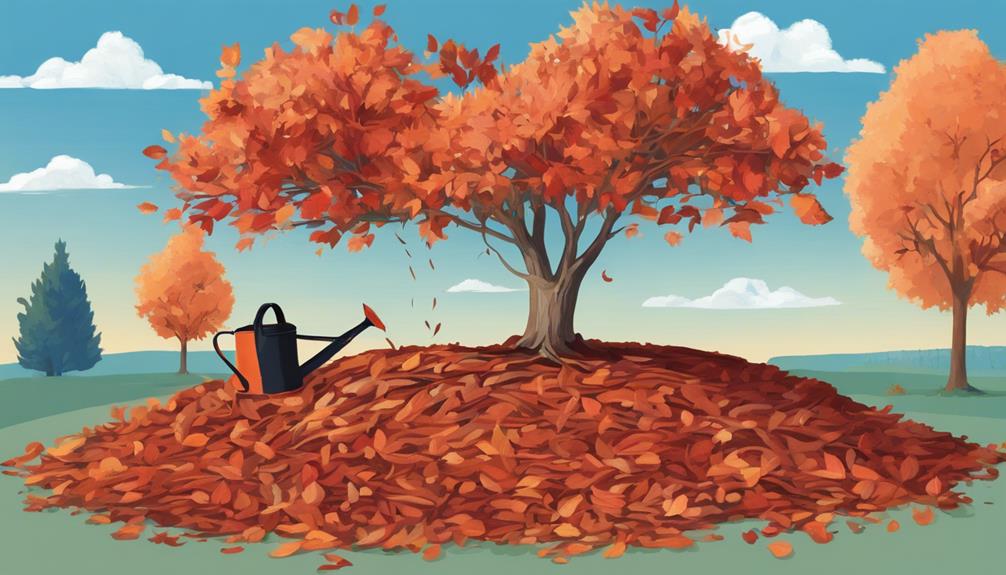What Are the Best Tips for Hedge Trimming?
28 January 2025
What Tools Do You Need for Garden Care?
28 January 2025Top seasonal tree care tips include regular pruning, timely fertilisation, and vigilant pest monitoring.
Prune trees during dormancy in late winter or early spring to promote healthy growth.
Apply balanced fertilisers in early spring and summer to meet varying nutritional needs.
Effective irrigation, using techniques such as drip systems, guarantees adequate moisture without overwatering.
Regular soil tests will help inform nutrient requirements.
Consider professional tree care services for tailored advice and advanced pest management strategies.
These practices improve tree longevity and enhance overall landscape aesthetics.
Investigate supplementary insights for optimising tree health and understanding its importance throughout the changing seasons.
Seasonal Tree Health Essentials
Maintaining ideal tree health requires a strategic approach to both pruning and fertilisation tailored to the changing seasons.
Proper pruning techniques not only improve the tree's structure and growth but also help prevent disease.
Furthermore, seasonal fertilisation guidelines ensure that trees receive the necessary nutrients to thrive throughout the year.
Proper Pruning Techniques
Effective pruning is crucial for promoting the health and vitality of trees throughout the seasons. Mastering proper pruning techniques involves understanding the biology of the tree and the purpose of the cuts.
Begin by removing dead, damaged, or diseased branches to encourage healthy growth. Utilise the three-cut method for larger limbs: the initial cut on the underside prevents tearing, the second cut from above removes the limb, and the final cut at the branch collar promotes rapid healing.
Prune during dormancy for deciduous trees, ideally in late winter or early spring. For flowering species, timing depends on whether they bloom on old or new wood.
Always use sharp, sanitised tools to ensure clean cuts, minimising stress and the risk of infection.
Seasonal Fertilization Guidelines
Understanding the nutritional needs of trees throughout the year is vital for promoting robust growth and resilience.
Fertilisation should be tailored to the specific species and local soil conditions. In early spring, apply a balanced fertiliser to stimulate growth as trees awaken from dormancy.
Mid-summer is ideal for a nitrogen enhancement, especially for fast-growing varieties, improving foliage density.
For trees experiencing stress or nutrient deficiency, a targeted late-summer application of slow-release fertilisers can strengthen health before winter dormancy.
It is important to conduct soil tests to determine pH and nutrient levels, allowing for informed decisions on fertiliser type and quantity.
Proper application timing and technique guarantee optimal absorption, safeguarding your trees' health and longevity through every season.
Tree Species Selection Importance
Choosing the appropriate tree species is crucial for promoting a healthy landscape and ensuring optimal growth.
Factors such as soil quality, susceptibility to pests and diseases, and effective pruning techniques play a key role in this decision-making process.
Understanding these elements can significantly enhance the vigour and resilience of the trees in your care.
Soil Quality Assessment
Soil quality plays a pivotal role in the successful establishment and growth of tree species, as it directly influences their health and longevity.
Evaluating soil quality involves understanding its physical, chemical, and biological properties, which are crucial for selecting the appropriate tree species.
Key factors to consider include:
- Soil pH: Determines nutrient availability and microbial activity, affecting tree growth.
- Nutrient Content: Essential macronutrients and micronutrients must be present in adequate amounts to support tree development.
- Texture and Drainage: Soil texture influences water retention and aeration, which are critical for root health.
Pest and Disease Management
How can effective pest and disease management greatly impact the longevity of trees?
Selecting tree species with inherent resistance to local pests and diseases is essential for ensuring long-term health. This proactive approach minimises the risk of infestation and disease, consequently enhancing the resilience of the landscape.
Additionally, understanding local environmental conditions can guide the selection process, allowing for trees that thrive in native ecosystems.
- Prioritise species known for pest resistance.
- Consider local climate and soil conditions.
- Regularly monitor for early signs of pests or disease.
Pruning Techniques for Healthy Growth
Effective management of pests and diseases lays the groundwork for robust tree health, which is further enhanced through appropriate pruning techniques.
Pruning not only improves the tree's structural integrity but also promotes airflow and sunlight penetration, both essential for photosynthesis. Understanding the specific needs of each tree species is paramount, as different species respond distinctly to pruning.
- Timing: Prune during the dormant season for most species to minimise stress and encourage growth.
- Technique: Use clean, sharp tools to make precise cuts; this reduces the risk of injury and disease.
- Assessment: Regularly evaluate the tree's health and growth patterns to inform future pruning decisions.
Mastering these techniques ensures ideal growth and is of great importance for your trees.
Soil Testing and Preparation
Effective tree care begins with understanding the soil environment in which they grow. Conducting a soil pH level check is crucial to ensure optimal nutrient availability, while mulching aids in moisture retention, promoting healthy root development.
Furthermore, techniques such as root grafting can enhance resilience, preparing trees for seasonal changes and potential stressors.
Soil Ph Level Check
Regularly checking the pH level of your soil is essential for optimal tree health and growth. The pH level influences nutrient availability, microbial activity, and overall soil composition, directly impacting tree health.
To ensure your soil is conducive to tree flourishing, consider the following steps:
- Conduct a soil test: Utilise a reliable soil testing kit or send samples to a professional laboratory for accurate results.
- Amend as necessary: Based on the test results, adjust the soil pH with lime to raise it or sulphur to lower it, ensuring ideal nutrient uptake.
- Monitor regularly: Make soil pH testing a routine part of your seasonal tree care to maintain optimal conditions for growth.
Adopting these practices will improve your trees' resilience and longevity.
Mulching for Moisture Retention
A well-planned mulching strategy can significantly enhance moisture retention in the soil, which is crucial for the health of your trees. Effective mulching not only conserves moisture but also improves soil quality and protects against temperature fluctuations.
To optimise these benefits, consider the following:
- Use organic materials: Options such as wood chips, straw, or shredded leaves decompose over time, enriching the soil.
- Apply the right thickness: Aim for a mulch layer of 5-10 cm to balance moisture retention and prevent oxygen depletion.
- Keep mulch away from trunks: Maintain a gap around the base to prevent moisture-related diseases and promote healthy air circulation.
Implementing these strategies will foster robust tree growth and resilience against environmental stressors.
Root Grafting for Resilience
Conducting thorough soil testing is vital for successful root grafting, as it provides valuable insights into soil composition and nutrient availability. Understanding these factors allows for precise amendments, promoting ideal conditions for graft success and tree resilience.
Key aspects to evaluate during soil preparation include:
- pH Levels: Ensuring the soil pH is within the ideal range for the specific tree species improves nutrient absorption.
- Nutrient Profile: Identifying deficiencies or excesses in fundamental nutrients informs targeted fertilisation strategies.
- Soil Texture: Analysing soil texture aids in determining drainage capabilities and root penetration potential.
Enhanced Tree Longevity
To enhance the longevity of your trees, it is essential to implement a comprehensive care strategy that addresses their unique needs throughout the seasons. Regular assessments and tailored interventions can significantly extend their lifespan. Key practices include proper watering, mulching, and periodic pruning to promote healthy growth and vitality. Furthermore, monitoring soil health plays a crucial role in nutrient availability.
| Care Practice | Best Timing | Benefits |
|---|---|---|
| Watering | Spring and Summer | Supports root development |
| Mulching | Early Spring | Retains moisture, suppresses weeds |
| Pruning | Late Winter/Early Spring | Encourages a strong structure |
| Soil Testing | Annually | Identifies nutrient deficiencies |
Implementing these strategies will not only enhance tree longevity but also contribute to a thriving landscape.
Organic Pest Control Techniques
Organic pest control techniques are essential for maintaining the health and vigour of trees while minimising chemical use.
Key methods include the application of neem oil sprays, which effectively deter pests, alongside the strategic distribution of fertiliser granules and liquid sprays to enhance plant resilience.
Neem Oil Spray Application
Applying neem oil spray is an effective method for managing pests in your garden while promoting a healthier ecosystem. This organic solution disrupts the life cycle of various harmful insects, including aphids, spider mites, and whiteflies, without harming beneficial organisms.
To ensure successful application, consider the following tips:
- Dilution Ratio: Mix neem oil with water and a few drops of mild soap to enhance its efficacy.
- Timing: Apply during early morning or late afternoon to minimise evaporation and maximise absorption.
- Coverage: Thoroughly coat both the upper and lower surfaces of the leaves for optimal pest control.
Fertilizer Granule Distribution Method
Effectively distributing fertiliser granules is crucial for enhancing plant health and supporting integrated pest management strategies in your garden.
Precision in application not only guarantees optimal nutrient absorption but also minimises waste and environmental impact.
To achieve uniform granule distribution, consider the following techniques:
- Hand Distribution: Ideal for small areas, this method ensures careful placement around the root zone while avoiding direct contact with stems.
- Broadcast Spreaders: Suitable for larger spaces, these tools provide even coverage and are adjustable for different granule sizes.
- Soil Incorporation: Lightly raking the area after application promotes granule engagement with the soil, enhancing nutrient availability.
Fertilizer Liquid Spraying Technique
In relation to enhancing plant health while managing pests, employing the fertilizer liquid spraying technique can significantly improve nutrient uptake and provide an effective organic pest management solution.
This method facilitates the rapid absorption of nutrients through foliage, delivering essential elements directly to the plant's cells. Additionally, the moisture from the spray can assist in deterring pests and diseases.
- Ensures even distribution of nutrients across the leaf surface.
- Reduces the risk of nutrient leaching, maximising efficiency.
- Enhances the resilience of plants against pest invasions.
Implementing this technique requires careful timing and formulation, ensuring that the correct concentrations are used to optimise both growth and pest resistance.
Mastery of this method can greatly strengthen your tree care practices.
Pest Infestation Remedies
Addressing pest infestations effectively requires a combination of methods to ensure the health of your trees.
Utilising insecticidal soap can provide a direct approach to combating harmful insects, while companion planting can serve as a natural deterrent.
Additionally, implementing effective irrigation strategies can strengthen tree resilience and reduce vulnerability to pests.
Insecticidal Soap Application Method
To combat pest infestations on trees, the application of insecticidal soap serves as an effective and environmentally friendly remedy. This method targets soft-bodied insects such as aphids, spider mites, and whiteflies, disrupting their cellular structure and effectively eliminating them.
For optimal results, adhere to the following guidelines:
- Timing: Apply insecticidal soap during the cooler parts of the day to minimise evaporation and protect beneficial insects.
- Dilution: Follow the manufacturer's instructions for proper dilution rates to ensure efficacy without harming the plant.
- Coverage: Thoroughly coat the affected areas, including the undersides of leaves, to ensure complete contact with pests.
Companion Planting for Pest Control
Utilising companion planting as a strategy for pest control can significantly enhance the health and resilience of your trees.
By strategically pairing plants, you can naturally deter pests, attract beneficial insects, and improve overall tree vitality. This ancient practice not only fosters a balanced ecosystem but also reduces the reliance on chemical pesticides.
- Marigolds: Emit compounds that repel nematodes and aphids.
- Basil: Attracts pollinators while repelling flies and mosquitoes.
- Nasturtiums: Act as a trap crop, drawing aphids away from trees.
Integrating these companion plants into your landscape can create a synergistic environment that promotes pest resistance and enhances the aesthetic appeal of your garden.
Adopt companion planting to master the art of sustainable tree care.
Effective Irrigation Strategies
Implementing effective irrigation strategies is crucial not only for the growth and health of your trees but also for mitigating pest infestations. Proper moisture levels can fortify trees, making them less susceptible to pests and diseases.
Here are key strategies to consider:
- Drip Irrigation: This method delivers water directly to the root zone, reducing runoff and minimising the risk of fungal diseases often associated with wet foliage.
- Soil Moisture Monitoring: Utilise sensors to gauge soil moisture levels, ensuring trees receive ideal hydration without overwatering, which can attract pests.
- Mulching: Applying organic mulch retains soil moisture and regulates temperature, creating an unfavourable environment for pests while promoting healthy root development.
Adopting these strategies fosters resilience in trees and enhances their defences against potential pest threats.
Why Choose TKL Birmingham Gardener
When it comes to preserving the health and beauty of your trees, TKL Birmingham Gardener is your trusted partner.
Our team of certified arborists employs advanced techniques and extensive knowledge to ensure your trees receive the finest care possible. We understand that each tree species has unique requirements, and we tailor our services to meet those specific needs.
Our commitment to sustainability and environmentally friendly practices ensures that your landscape thrives without compromising ecological balance.
By choosing TKL Birmingham Gardener, you gain access to expert consultations, precise pruning, and comprehensive disease management strategies. Our proactive approach guarantees that your trees not only survive but flourish, enhancing the overall aesthetic and value of your property.
Partner with us for unrivalled tree care expertise.
Common Tree Care Questions
As you consider the benefits of partnering with TKL Birmingham Gardener for your tree care needs, it's natural to have questions about the best practices for maintaining the health and vitality of your trees.
Common inquiries often revolve around watering frequency, proper pruning techniques, and pest management strategies. Understanding the specific needs of different tree species is crucial, as each may require tailored care.
Furthermore, many tree owners seek clarity on soil health and fertilisation best practices to promote robust growth. Seasonal changes also prompt questions about when to perform specific maintenance tasks.
Seasonal Care Reminder Checklist
To maintain the health and vigour of your trees throughout the year, a thorough seasonal care reminder checklist is essential.
By adhering to this checklist, you can ensure your trees thrive in their environment and reduce the risk of disease and pest infestations.
- Spring: Prune dead or diseased branches and apply a balanced fertiliser to promote growth.
- Summer: Monitor for pests and water adequately, especially during dry spells.
- Autumn: Rake fallen leaves to prevent fungal infections and mulch around the base for insulation during winter.




